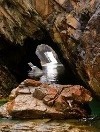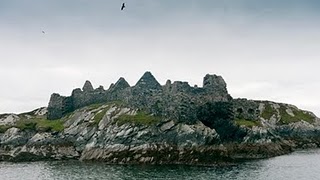Read more from Caroline here.
The ferry from Cleggan to Inis Bofin is best taken in the rain, so you can taste the damp salty air and play hide and seek with the islands as they come and go through the mist. If you're lucky the crossing will be flat calm, the wake stretching out behind you, and you'll wonder about the lives of the people of Connemara who have rowed their currachs between the islands to tend their sheep and potato crops for hundreds of years.
There are stories to tell about the old ruined fort which that welcomes you as you enter the mouth of the harbour. If you're lucky enough as we were to have historian Micheal Gibbons at your side you'll be regaled with tales of English Garrisons on the island, the wrecks of the Spanish Armada that litter the coastline, Irish politics and in-fighting, inheritance and war in this nation of a hundred countries.
You'll be helped off the ferry by the crew warning you to mind your fingers, then make your way past the lobster pots, bicycles and beer kegs along the quay and up the road to the pub where you'll sit and steam and enjoy hot soup and good coffee and listen to Micheal's history of the Battle of the Boyne before you start exploring the island.
Micheal Gibbons and Rachel Ryan looking at the Bronze Age Hill Fort on Inis Bofin
Then maybe you'll walk along the island track to the bronze age hill fort that sits to the west, on a rocky promontory looking out to sea, easily defended against attack from all sides. They built their walls and their houses well, these people. So well that we can map the traces of their lives etched on the landscape despite the warm blanket of bog that has settled on it since.
If you are lucky the rain and the mist will let you into more of the islands secrets – maybe the sun will break through the cloud mantle as you walk across the bog lands that lie below the fort, cut for generations by island families to warm their hearths. A soft island light might illuminate the mouth of the sea caves and inlets that adorn the coastline like so many pretty stones on a necklace your grandmother gave you, a piece of history – maybe true, maybe not – attached to each one.
You could meet a local fisherman who will share his best recipe for mackerel or lobster, and walk the road back to the pub with you – where you'll sit in the warm again and down a black-as-peat Guiness while you reflect on what it would be like to spend days and nights, maybe a lifetime, on an island in the West of Ireland.
Inis Bofin Mackerel:
Use feathers as a lure – they like the bright and shiny things.
First fillet your mackerel. (Save the bones for good fish stock).
Brush fillets lightly with hot english mustard and a scraping of butter
Grill until cooked.
Eat with soda bread and butter and a glass of cold Guiness.
Island Lobster:
Use pollock for bait in your lobster pot, and keep the crabs away as the lobsters and crabs don't see eye to eye.
Blanch your lobster in boiling water for 10 minutes
Cut in half lengthwise, spread the white flesh generously with butter and grill for five minutes.
Eat as for the mackerel.











Join the Discussion
Type out your comment here:
You must be logged in to post a comment.